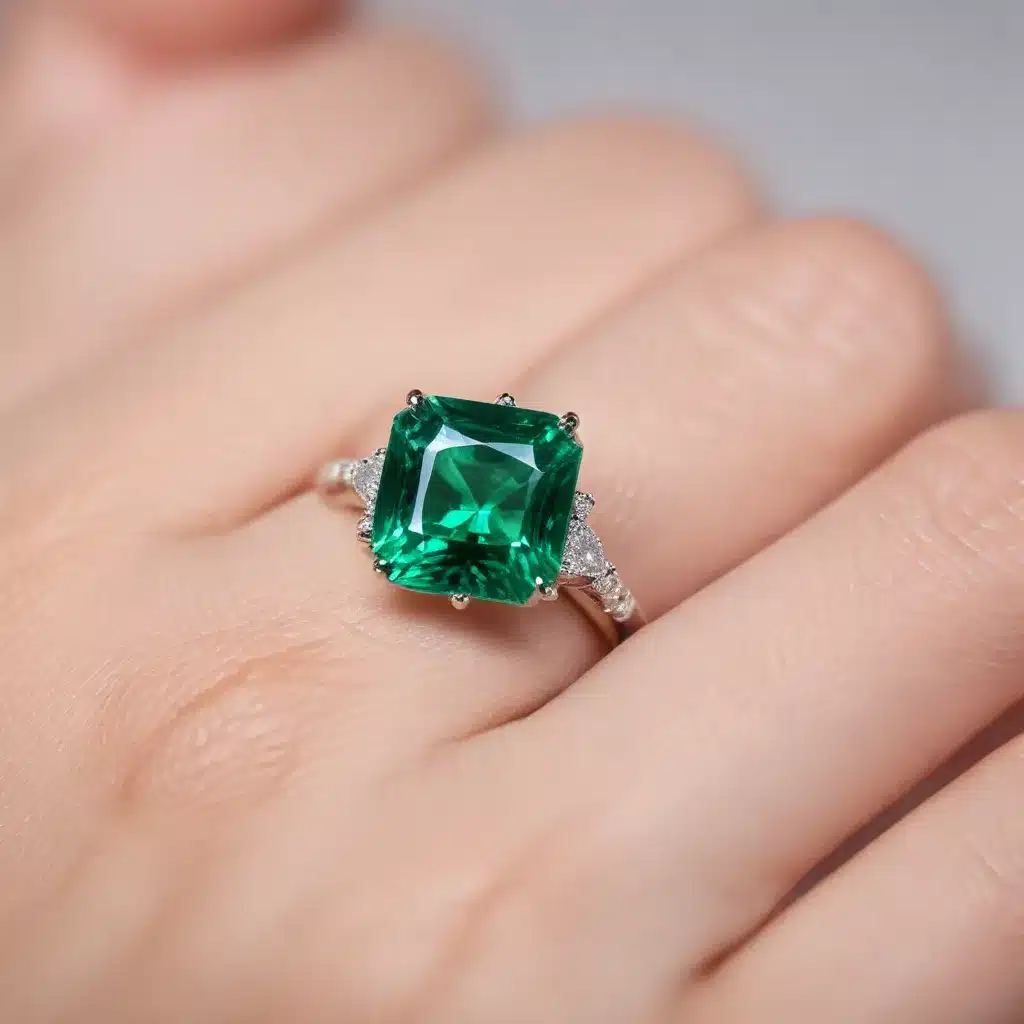
Exploring the Science Behind Lab-Grown Emeralds
As a gem and jewelry expert at Shelby Gem Factory, I’m delighted to dive into the fascinating world of lab-grown emeralds. These synthetic gems have become increasingly popular in recent years, offering an ethical and affordable alternative to their mined counterparts. But what exactly sets them apart, and how are they produced? Let’s unpack the science behind these captivating green gemstones.
Crystalline Structure and Composition
At their core, emeralds are a variety of the mineral beryl, with the chemical formula Be3Al2(SiO3)6. The emerald’s distinctive green color is attributed to the presence of trace amounts of chromium and, occasionally, vanadium within the crystal structure. This atomic arrangement gives emeralds their characteristic refractive index, birefringence, and pleochroism – properties that distinguish them from other beryl varieties.
In the laboratory setting, researchers can precisely control the growth conditions to replicate the natural formation of emeralds. By carefully manipulating factors like temperature, pressure, and the concentration of key elements, they can produce synthetic emeralds with an identical atomic structure to their mined counterparts. This level of control allows for the elimination of common natural inclusions, resulting in a more flawless, pristine clarity.
Synthesis Techniques
Two primary methods are used to grow emeralds in the lab: the High-Pressure High-Temperature (HPHT) method and the Flux-Growth method. The HPHT process involves subjecting a beryl seed crystal to extreme heat and pressure, mimicking the natural conditions deep within the Earth’s crust where emeralds form. The Flux-Growth method, on the other hand, relies on a specially formulated molten solution that encourages the slow, controlled growth of the emerald crystal.
While both techniques can yield high-quality synthetic emeralds, the Flux-Growth method is generally preferred for its ability to produce larger, more vivid-colored gems. The slow, gradual growth process allows for the incorporation of chromium and other trace elements in a way that closely replicates the natural formation of emeralds.
Optical Properties
Emeralds, both natural and synthetic, exhibit a captivating array of optical properties that contribute to their allure. Their refractive index, which measures the speed of light as it passes through the crystal, is typically around 1.577 to 1.583 – a range that gives emeralds their distinct brilliance and fire. The emerald’s birefringence, or the difference in refractive index between two light rays passing through the crystal, is also a key factor in its visual appeal, creating a subtle doubling effect.
Interestingly, many lab-grown emeralds can actually surpass their natural counterparts in terms of optical perfection. The controlled growth environment allows for the elimination of common inclusions and imperfections, resulting in a higher clarity and more vibrant color that is often more consistent throughout the gemstone.
Manufacturing Processes
The production of lab-grown emeralds is a meticulous, multi-step process. It begins with the careful preparation of a seed crystal, which serves as the foundation for the gem’s growth. This seed is then placed in a specialized growth chamber, where the temperature, pressure, and chemical composition are meticulously regulated to encourage the formation and expansion of the emerald crystal.
Once the desired size is achieved, the rough crystal is subjected to a series of cutting and polishing techniques to enhance its optical properties and create the desired facet arrangement. Master cutters use precise measurements and angles to ensure maximum brilliance and fire, often sacrificing a significant portion of the rough material to achieve the optimal result.
Distinguishing Natural and Lab-Grown Emeralds
With the advancements in synthetic gem technology, it can be challenging for even the trained eye to distinguish a lab-grown emerald from a natural one. However, gemmological laboratories have developed a range of analytical techniques to identify the origin of these stones.
Spectroscopic analyses, such as UV-Vis-NIR spectroscopy and Raman spectroscopy, can detect subtle differences in the atomic structure and chemical composition of natural and lab-grown emeralds. Microscopic examination can also reveal the presence or absence of certain inclusions and growth patterns that are characteristic of each variety.
Moreover, international gem testing standards and certification programs play a crucial role in ensuring transparency and consumer awareness. By obtaining a reputable laboratory report, buyers can be confident in the origin and authenticity of their emeralds, whether mined or grown in a controlled environment.
Environmental Impacts
One of the primary drivers behind the growing popularity of lab-grown emeralds is their perceived environmental sustainability. While the manufacturing process does require significant energy input, it eliminates the need for destructive mining practices that can harm fragile ecosystems and disrupt local communities.
The Flux-Growth method, in particular, is often considered the more eco-friendly approach, as it typically consumes less energy and generates fewer greenhouse gas emissions compared to the HPHT process. Additionally, the ability to recycle and reuse the growth chambers and other materials in the Flux-Growth method further enhances its sustainability profile.
Market Trends and Implications
As consumers become increasingly conscious of the ethical and environmental implications of their purchasing decisions, the demand for lab-grown emeralds has soared. These synthetic gems are not only more affordable than their mined counterparts but also offer a conflict-free and sustainable alternative that aligns with the growing preference for ethical and responsible sourcing.
Moreover, the technological advancements in gem synthesis have opened up new avenues for innovation in the jewelry industry. Designers and jewelers are now exploring novel cutting and setting techniques to showcase the unique optical properties of lab-grown emeralds, further expanding the creative possibilities in fine jewelry design.
At Shelby Gem Factory, we are proud to offer a wide selection of high-quality lab-grown emeralds that meet the most stringent gemmological standards. Whether you’re looking for a birthstone with a rich history or a custom-designed piece that showcases the mesmerizing brilliance of these synthetic gems, our team of experts is here to guide you through the process and help you find the perfect addition to your collection.

